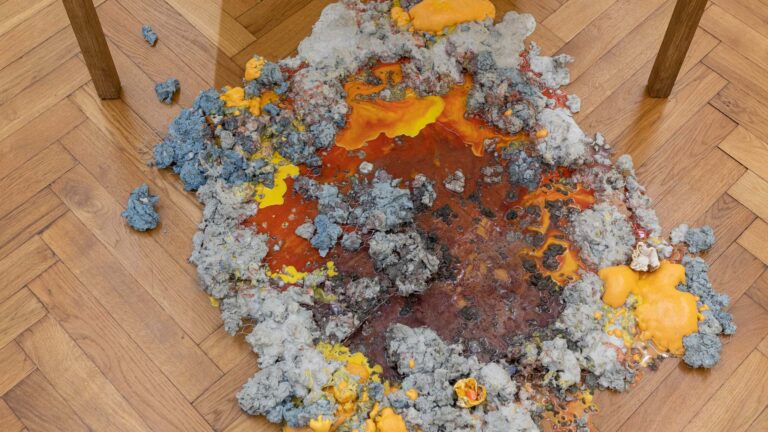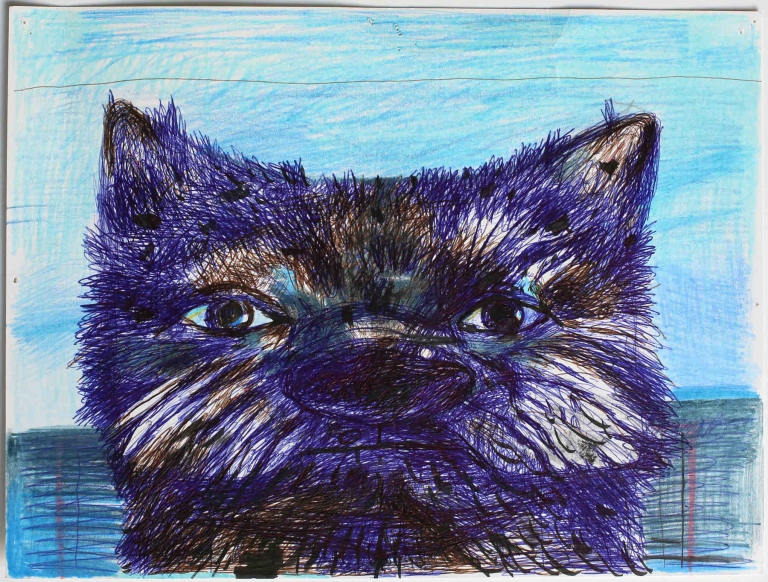Artist: Philip Gaißer
Exhibition title: Under the Pavement, the Sand
Venue: Neuer Essener Kunstverein, Essen, Germany
Date: September 15 – November 18, 2018
Photography: all images copyright and courtesy of the artist and Neuer Essener Kunstverein
*
When I told her about the sand, it reminded her of playing with pieces of sea glass on the beach as a child. With their smooth edges they were an excellent substitute for candy, and they were colorful, too. But the beach Ines was talking about was somewhere on the Baltic. What a paradise the beach at Fort Bragg, California, would have been for her! Over a period of decades, glass and ceramics were dumped into the ocean, washed back up onto the beach years later as smooth-ground fragments. Today, Glass Beach is a tourist attraction.
*
It turns out that the movements of the glass fragments resemble that of sand on the ocean floor. Ground down further still, the grains of glass can even be used as a substitute for sand in concrete. At least the producers of the substitute material hope so. The first product containing recycled glass to be authorized is a rapid building block – concrete Lego bricks that have already been used as guardians and street furniture outside major event locations.
*
My first memory of sand is when excavators came in 1986 to shovel the contents of my local playground into lockable metal crates. Several weeks later, the empty pits were refilled with fresh, yellow sand. People said it came from Spain. Had I taken a glass of this sand with me at the time, it might have been more than the start of a big collection. I would also have been following a trend, allowing me to stick a pin in my map to mark Spain. After all, it’s not unusual to bring something back from vacations – even if it’s just sand.
*
To visit the gardens of Nifa, I drive from Olevano through the plain of Lazio toward Latina. To the left and right of the highway, deep swathes are cut into the mountains—here in Germany they might be called gravel pits. The province of Latina is especially well suited to sand mining because until 1930 is was a swamp where deposits of sand had built up over centuries. When the swamp was drained in the 1930s, settlement of the region began, accompanied by planned development.
*
Back in Olevano, I continue my observation of a mason bee that began several days ago to attach a stone to the wall. To achieve this, it brings sand to its new habitat and mixes it with its saliva. It will be some weeks before the nest is finished, the egg cells are closed, and the bee has departed. In spring, her offspring will then start the whole cycle over again.
*
The Lazio region has plenty of experience with unregulated construction. In the seventeenth century, the nephew of Pope Urban VIII extended a ruin in Palestrina to create a spacious country residence. The Barberinis always did have a well-developed feel for architecture. To realize his ideas, the Pope authorized the Colosseum in Rome to be used as a quarry. The Barberinis came from Tuscany where the family coat of arms was decorated with a rather rural-looking horsefly. When Maffeo Barberini moved to Rome to take on his new role as head of the Catholic church, the horsefly was replaced with a more elegant bee. In Palestrina, too, the old heraldic creature was removed from the palace façades and replaced with the new one.
*
At first, my attempts to find a surviving horsefly in Palestrina were in vain. Finally, I received help from a German architect with a weakness for geometry. He had set himself the task of surveying buildings with geometric floorplans. One site he found is in Palestrina: outside the city walls stands a dilapidated residential tower built on the footprint of an equilateral triangle, whose original function is not entirely clear. The architect was not going to be able to solve the mystery surrounding the tower; he just wanted to know if its geometry was correct. In the tower’s entrance hall, the horsefly could still be seen in a mosaic on the floor.
*
That evening, Michael told me about a hotel complex he had previously surveyed on the coast. The building, planned in the 1980s on a square footprint, had never been completed. Once the basic structure was in place, a dispute erupted over the legal status of the project, partly due to the ugliness of the building in the landscape and partly because of the planned hotel’s location in a nature reserve. The building was never finished, still standing today as the epitome of the concept of ecomostro. A buzzword in the Italian environmental movement of the 1980s, it means something along the lines of “desecrating the countryside with concrete”. When I show him the mason bee’s building project, even though the geometry is correct, he is only mildly impressed.




























